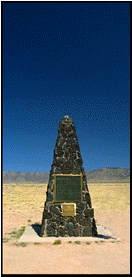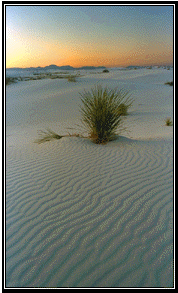May 17, 1996
On the morning of July 16, 1945 at 5:29 a.m., the desolate peace of a remote New Mexican valley was incinerated by the fire of a powerful man-made star. From that spectacular flash of eternity, the world changed forever. No more wars of spears and bludgeons, no quaint “lines of fire” by brightly dressed troops. War was now a strange, new beast, identified by the fascinating, violet-hued mushroom cloud after a collection of the U.S. Army’s most brilliant physicists detonated the first atomic bomb.
 A visit to this historic site in the middle of a beautiful but austere landscape, prophetically named Journey of Death (Jornada del Muerto) by 17th-century Spanish settlers, combines the severe gravity of history with one of the West’s loneliest and most historically significant outposts.
A visit to this historic site in the middle of a beautiful but austere landscape, prophetically named Journey of Death (Jornada del Muerto) by 17th-century Spanish settlers, combines the severe gravity of history with one of the West’s loneliest and most historically significant outposts.
The Trinity Site lies isolated in the northern section of White Sands Missile Range about an hour and a half due south of Albuquerque. The landscape around and south of Albuquerque looks like it had already been subjected to mass nuclear detonation. This dull, mustard-colored, scrub-desert dotted with clumps of tough grass and creosote bush confirms the Army picked the right place for testing atomic fission. Low, eroded volcanic mounds sulk here and there. The sky is a light sapphire blue, thin and dry. Mexican canciones, whimsical Spanish polkas playing on the radio, contrast with the harsh scenery rolling by.
Arriving at the northern sentry post at the White Sands gate, I’m crestfallen. I expected to see crisp uniforms, butch guards and M-16 rifles. Instead I’m given a nifty little tour booklet by a rotund redneck in a baseball cap. Two older women who looked like they just baked pies for the Alamogordo Ladies Auxiliary wave us on. No black helicopters, strip searches or interrogations? Isn’t our national security at stake?
I travel onward past non-descript military buildings and pull into the dusty parking lot near the barbed-wire-fenced Trinity Site. A large sign instructs visitors not to eat, drink or apply make-up, contradicting, it seems, the tour booklet’s proclamation that radioactivity at the site is safe.
Near the entrance were a few lame concession booths filled with cheesy T-shirts, coffee mugs, key chains and bumper stickers. Cans of Coke were $1.50 each, but we remember not to drink amidst the “safe” radioactivity on the site.
We walk the quarter mile to Ground Zero past bored security personnel and paramedics. Unceremoniously, the Trinity Site itself is marked by a diminutive lava-rock obelisk in the center of a square formed by the crumbling concrete caissons and stubby steel legs of the tower. A bomb casing rests on a civilian flatbed truck.
The first atomic bomb was exploded atop a 100-foot steel tower at this spot. The 19-kiloton blast melted the desert sand into a crust of shiny green glass called Trinitite. The kiloton designation of an atomic-blast measurement helps provide perspective on the enormity of this first firecracker and the much more powerful hydrogen bombs that came later.
 The shock wave from the bomb broke windows 120 miles away and was felt by others 160 miles distant.
The shock wave from the bomb broke windows 120 miles away and was felt by others 160 miles distant.
The 8,000-foot Oscura Mountains to the east of the Trinity Site are black-and-gray razorbacks of hostility. The wind whips through the 8-foot tall, barbed-wire chain link surrounding the Trinity Site, rattling black-and-white photos of the bomb and its creators hanging on the fence. Except for the paraphernalia at the site, there are no other signs of civilization as far as the eye can see. It looks as it did when the first Spanish explorers rode their steeds through the dust and sparse yellow grass.
A fellow visitor is stooped over, walking like a peasant, violating federal law by collecting small nuggets of Trinitite still abundant around Ground Zero. Again, I’m disappointed, as I expect gun-toting MPs to drop from camouflaged Bell Hueys. No such luck. Just frowns from a couple of army guys in a white van. At least they could have gassed up the half-track for the taxpayers.
The chunks of Trinitite are about a half-inch square and a quarter-inch thick, a shiny avocado green, except for a thin layer of sand on the bottom. The blast turned a 500-yard diameter circle of desert into a quarter-inch-thick plate of radioactive crystal the color of most 1970s major appliances. In my hand I hold a moment of time: Year Zero of the Atomic Age.
 It is a quiet place, this place that changed the world. From this sandy spot, this arid Pandora’s Box, came the quick end to WWII, duck-and-cover drills, Bikini Atoll, MIRVs, ICBMs, and a world still holding its breath for the first municipal vaporization by a deranged group of terrorists.
It is a quiet place, this place that changed the world. From this sandy spot, this arid Pandora’s Box, came the quick end to WWII, duck-and-cover drills, Bikini Atoll, MIRVs, ICBMs, and a world still holding its breath for the first municipal vaporization by a deranged group of terrorists.
As I stand here, looking at the sun, I try to imagine what it must have been like, as one of the physicists at Los Alamos, to count down to an instant unimaginable except from numbers on blackboards and measurements on magnetrons. I try to imagine how they must have felt unleashing this terrible force, knowing it would end a war, but change the planet forever.
I try to imagine a simpler world, without weapons of mass destruction, where wars are fought with swords and knives, with lances and giant axes, where huge 250-pound mastiffs clamp hot jaws on your midsection and rip your guts out. Actually, instantaneous vaporization doesn’t sound too bad.
The gates to the Trinity Site open only twice a year, from 9 a.m. to 2 p.m. on the first Saturdays in April and October. Part of the site tour is a bus ride to the McDonald Ranch where the plutonium core was assembled. Accommodations are best had in Albuquerque or Alamogordo, near White Sands National Monument (with luxurious dunes of baby powder-like gypsum deposits) and farther south, Carlsbad Caverns.
Story and photos by Joseph Falco